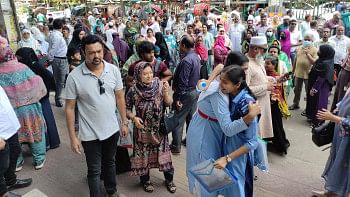Hope for endangered gharials

Jamuna, the female gharial in Rajshahi Zoo, laid eggs after two years of a pioneering attempt for captive breeding of the freshwater reptile that is listed as “critically endangered” on the IUCN Red List.
Unfortunately, the eggs were rotten underwater following an overflow in the gharials’ enclosure at the Shaheed AHM Qamaruzzaman Central Park and Zoo, experts said.
Lack of experience and required infrastructure for captive breeding of the reptile in the enclosure was also blamed for the damaged eggs, they added.
In the second week of July, the zoo authorities recovered two eggs for the first time after those were found floating in the water, said Dr Farhad Uddin, veterinary surgeon of the zoo.
The same way, they found two more rotten eggs in the second week of October, Dr Farhad, also in-charge of the zoo, said.
The whole experience was a first for the zoo authorities.
“We did not know when they laid the eggs. We discovered them only after the rotten eggs were seen floating on water,” Dr Farhad said.
“It is big news for us that they (gharials) began laying eggs,” said Sarowar Alam, a wildlife biologist of the International Union for Conservation of Nature (IUCN).
“We’ve decided to take effective measures for proper protection of the eggs and their successful hatching in the next season,” Alam who authored an international research paper on gharials, said.
IUCN declared gharials a critically endangered species in Bangladesh in 2015.
They reported there are 200 of the reptiles around the world while Bangladesh has seen five to 10 juvenile gharials at seven points of Padma, Jamuna and Mahananda rivers every year.
In 2016, IUCN, jointly with the Department of Forest, conducted a study on gharials of Bangladesh with funds from the World Bank.
The study revealed that there are at least 11 captive gharials in the country and six of them are female.
Breeding of the captive reptiles was not happening as males and females were living separately, the study found.
Four male gharials were in Dhaka Zoo while four females were in Rangpur, one male in Bangabandhu Safari Park and two females in Rajshahi.
Acting on the findings in August 2017, IUCN, in collaboration with the Department of Forest and authorities of the zoos in Rajshahi and Dhaka, arranged an exchange of gharials for initiating captive breeding.
Gorai, a male gharial of Dhaka Zoo, was brought to Rajshahi to meet Jamuna. In similar fashion, another female gharial of Rajshahi was taken to Dhaka.
“The exchange was necessary for increasing the numbers of the critically endangered reptile,” Sarowar Alam said.
Since the exchange, the Rajshahi pair began laying eggs for the first time.
The enclosure of Rajshahi Zoo, where Gorai and Jamuna live, needs a renovation, Sarowar Alam observed.
He said the circular enclosure lacked the required slope around its banks so that the gharials can bask.
The enclosure has a circular sand covered island in the middle, but it gets submerged in water in rainy season -- making it difficult for the gharial to lay eggs and hatch them, he said.
The zoo in-charge Dr Farhad said the enclosure also lacks facilities of extraction of excess water. He said the zoo authorities began pumping out extra water from the enclosure after they found the eggs were being damaged.
Talking to The Daily Star yesterday, IUCN Country Director Raquibul Amin said, “Our experts are inexperienced, but they are working towards success.”

 For all latest news, follow The Daily Star's Google News channel.
For all latest news, follow The Daily Star's Google News channel. 



Comments